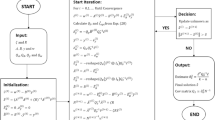Abstract
The Newton method has been widely used for solving nonlinear least-squares problem. In geodetic adjustment, one would prefer to use the Gauss–Newton method because of the parallel with linear least-squares problem. However, it is proved in theory as well as in practice that the Gauss–Newton method has slow convergence rate and low success rate. In this paper, the over-determined pseudo-distance equations are solved by nonlinear methods. At first, the convergence of decent methods is discussed after introducing the conditional equation of nonlinear least squares. Then, a compacted form of the Hessian matrix from the second partial derivates of the pseudo-distance equations is given, and a closed-form of Newton method is presented using the compacted Hessian matrix to save the computation and storage required by Newton method. At last, some numerical examples to investigate the convergence and success rate of the proposed method are designed and performed. The performance of the closed-form of Newton method is compared with the Gauss–Newton method as well as the regularization method. The results show that the closed-form of Newton method has good performances even for dealing with ill-posed problems while a great amount of computation is saved.




Similar content being viewed by others

References
Awange JL (2010) Algebraic geodesy and geoinformatics. Springer, Berlin
Awange JL, Fukuda Y, Takemoto S, Ateya IL, Grafarend EW (2003) Ranging algebraically with more observations than unknowns. Earth Planets Space 55(7):387–394
Awange JL, Grafarend EW (2003) Explicit solution of the overdetermined three-dimensional resection problem. J Geod 76(11–12):605–616
Chang XW, Guo Y (2005) Huber’s M-estimation in relative GPS positioning: computational aspects. J Geod 79(6–7):351–362
Dahlquist G, Eisenstat SC, Golub GH (1972) Bounds for the error of linear systems of equations using the theory of moments. J Math Anal Appl 37(1):151–166
Grafarend E (1989) The geometry of nonlinear adjustment-the planar trisection problem. Festschrift to T. Krarup pp149–172
Grafarend EW (2006) Linear and nonlinear models : fixed effects, random effects, and mixed models. Walter de Gruyter, Berlin, p 752
Grafarend EW, Schaffrin B (1991) The planar trisection problem and the impact of curvature on non-linear least-squares estimation. Comput Stat Data Anal 12(2):187–199
Grafarend EW, Schaffrin B (1993) Ausgleichungsrechnung in linearen Modellen. BI-Wissenschaftsverlag, Mannheim
Grafarend EW, Shan J (2002) GPS solutions: closed forms, critical and special configurations of P4P. GPS Solut 5(3):29–41
Junlin Y, Tiberius CCJM, Teunissen PJG, Bellusci G, Janssen GJM (2010) A framework for low complexity least-squares localization with high accuracy. IEEE Trans Signal Process 58(9):4836– 4847
Li WC, Wei P, Xiao XC (2009) A robust TDOA-based location method and its performance analysis. Sci China Series F Inf Sci 5:876–882
Madsen K, Nielsen HB, Tingleff O (2004) Methods for non-linear least squares problems, 2nd edn. Informatics and mathematical modelling, Technical University of Denmark, DTU
Sirola N (2010) Closed-form algorithms in mobile positioning: myths and misconceptions, positioning navigation and communication (WPNC). In: 2010 7th workshop on IEEE, pp 38–44
Teunissen PJ (1989) First and second moments of non-linear least-squares estimators. J Geod 63(3):253–262
Teunissen PJG (1990a) Nonlinear inversion of geodetic and geophysical data: diagnosing nonlinearity. In: Brunner FK, Rizos C (eds) Developments in four-dimensional geodesy. Springer, Berlin, pp 241–264
Teunissen PJG (1990b) Nonlinear least squares. Manuscripta Geodaetica 15(3):137–150
Teunissen PJG, Knickmeyer EH (1988) Nonlinearity and least-squares. CISM J ACSGC 42(4):321–330
Tsimis E (1973) Critical configurations(determinantal loci) for range and range difference satellite networks, Department of Geodetic Science, Ohio State University, Reports of the Department of Geodetic Science:191, Columbus 1973
Xue S, Yang Y (2013) Gauss–Jacobi combinatorial adjustment and its modification. Surv Rev doi:10.1179/1752270613Y.0000000086
Xue S, Yang Y, Dang Y, Chen W (2013) Dynamic positioning configuration and its first-order optimization. J Geod doi:10.1007/s00190-013-0683-7
Yan J, Tiberius C, Bellusci G, Janssen G (2008) Feasibility of Gauss–Newton method for indoor positioning. In: Position, location and navigation symposium, 2008 IEEE/ION. IEEE pp 660–670
Acknowledgments
We would like to thank the editors and the referees of this paper for their helpful comments. This work is partly supported by National Science Foundation of China (Grant No. 41020144004, 41104018), National High-tech R&D Program (grant No. 2009AA121405,2012BAB16B01) and GFZX0301040308-06.
Author information
Authors and Affiliations
Corresponding author
Rights and permissions
About this article
Cite this article
Xue, S., Yang, Y. & Dang, Y. A closed-form of Newton method for solving over-determined pseudo-distance equations. J Geod 88, 441–448 (2014). https://doi.org/10.1007/s00190-014-0695-y
Received:
Accepted:
Published:
Issue Date:
DOI: https://doi.org/10.1007/s00190-014-0695-y



